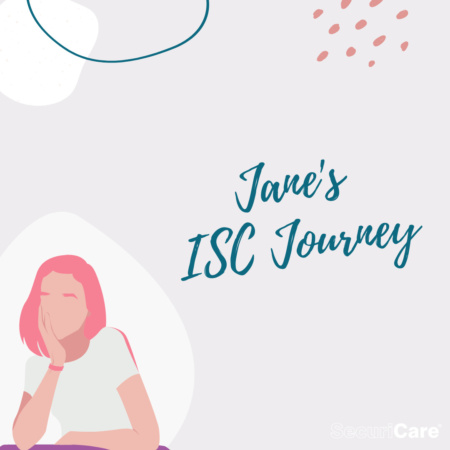Jane's ISC Journey

In 2017 at the age of 60, Jane was diagnosed with stage 2A cervical cancer. Her treatment included a radical hysterectomy which caused nerve damage to her bladder resulting in her needing to use catheters. In this article, Jane shares some of the challenges and lessons she’s learnt over the years.
Urinary Retention
Following my diagnosis of cervical cancer, my radical hysterectomy was performed using a robot assisted keyhole technique, which thankfully, has a quick recovery time. I was discharged from hospital the day after surgery with a Foley catheter and leg bag in place to help my bladder recover.
After a week with my Foley catheter, I had an appointment with a Gynaecology nurse to have a “trial without catheterisation” or “TWOC” and unfortunately was unable to pee a drop!
Over the following 3 weeks my catheter bag was replaced with a flip flow valve, and I had a course of medication to try to stimulate the bladder muscle. But to my dismay, I remained in total urinary retention.
When I had my flip flow, my bladder occasionally contained up to 700ml of urine. I was later informed that I shouldn’t allow my bladder to fill beyond 500ml, to prevent it getting overstretched which can lead to damage of the bladder muscle!
Starting Intermittent Self-Catheterisation
After another trip to gynaecology outpatients, I was taught to self-catheterise by a nurse.
The nurse asked me to sit on an examination couch with my knees bent and apart, a mirror and light positioned so I could view my urethral opening. I was then handed a foil packet containing a disposable catheter and the nurse talked me through the ISC procedure as I performed it. There was only time for 2 attempts, both of which I needed assistance. I was instructed to SC every 4-6 hours, and I was sent home with a carrier bag full of catheters.
I still remember walking to the railway station with a growing sense of fear and dread about how I was going to manage with a sensationless bladder, my questionable skill and a plastic tube.
The next 24 hours were challenging, I made my husband be with me while I self-catheterised, even in the small hours of the morning as my anxiety was off the charts.
In the afternoon of the following day, I only got about 50ml of urine from self-catheterisation and as the evening approached, I started to get abdominal discomfort. I panicked and called my GP surgery and through sheer luck a district nurse was on site and came to my rescue. It turned out I had about 800ml of urine in my bladder! The nurse explained that once urine starts to flow, it’s important to push the tube in a bit further (1-2cm) to ensure the eyelets of the catheter are fully in the bladder to ensure complete emptying.
So, I was now at a point where I could reliably self-catheterise, albeit I encountered problems with urethral trauma and discomfort whilst inserting the catheter tube. I eventually realised that, as well as relaxing, it helped to imagine where my bladder was and to angle the catheter tube appropriately which made all the difference.
After about a month, I relieved my husband from his ISC supervision duties. I set an alarm to wake me to self-catheterise during the night as sleeping through to morning with an overly full bladder was a concern for me.
Urinating naturally
I was advised to try and urinate naturally before self-catheterising and after about 2 weeks, it was very exciting to feel a trickle of urine albeit little more than a spoonful. Celebrations unfortunately didn’t last long as I received some bad news. My post hysterectomy histology results indicated further treatment was required and so, I underwent intense chemo-radiotherapy for 5 and a half weeks. The whole process was very distressing and unfortunately, during that time, I relapsed back into total urinary retention.
Not long after finishing my treatment, it was a great relief to find I could once again urinate naturally and over the following few months, the volumes I could pass gradually increased, as did the sensation in my bladder!
Jane’s Top tips for ISC (Based on personal experience)
- Avoid letting your bladder contain more than 500ml of urine. Occasionally check residual volumes and if applicable, check volumes naturally urinated too!
To help with discomfort/ difficulties whilst inserting/ withdrawing the catheter:
- Place a small blob of suitable lubricant on the end of the tube
- Imagine where the bladder is and angle the tube appropriately (check online for a diagram if you’re unsure!)
- Relax. Breathing out slowly whilst withdrawing the tube can be helpful.
- Body position makes a difference, so it’s worth experimenting
To reduce the risk of UTIs:
- Follow medical advice on how often you should self-catheterise
- Wash hands before and after ISC
- Use a mirror to locate the urethra, touch or instinct work well for some
- If the tube touches anything before the urethra, use a new catheter
- Take care to empty the bladder completely. Once urine starts to flow, push the tube in a 1-2cm further to ensure all of the eyelets are fully inside the bladder. When the urine flow ceases withdraw the tube slowly and stop if more urine starts to flow
- Keep pubic hair trimmed
- Keep well hydrated, limit caffeine and alcohol intake
- Speak to your doctor or nurse about home remedies that can help reduce urinary tract infections
Share this article:
by SecuriCare Team





